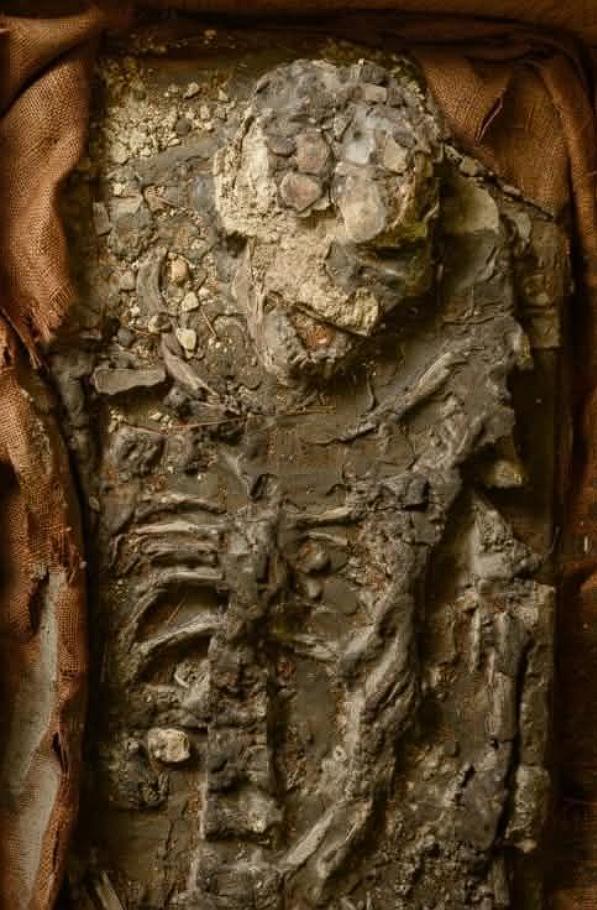For 85 years, a remarkable skeleton lay hidden within the depths of the Penn Museum in Philadelphia, an ancient relic forgotten until a chance discovery brought it back into the light. Encased in wax and sealed within a wooden box, this 6,500-year-old skeleton, affectionately nicknamed “Noah,” offers an extraordinary glimpse into humanity’s distant past, bridging the gap between legend and archaeological reality.
The Rediscovery: From Forgotten Relic to Archaeological Treasure
- A Hidden History: Decades in Storage:
- Originally excavated by the renowned British archaeologist Sir Leonard Woolley between 1929 and 1930, the skeleton was meticulously preserved in wax and stored in a wooden box, only to be forgotten for decades.
- A Chance Discovery: Digitizing Records:
- The skeleton’s rediscovery occurred during a project to digitize museum records. A missing entry led researchers to a wooden crate containing the remains of a man from the Ubaid period, a significant find that reignited scientific interest.
- “Noah”: A Name Reflecting Ancient Myths:
- Given the flood deposits surrounding his burial, the skeleton was aptly named “Noah,” a nod to the deep connections between Mesopotamian flood myths and the archaeological evidence found at the ancient city of Ur.
An Invaluable Find: Unveiling the Ubaid Period
- Excavations at Ur: Unearthing Ancient Mesopotamia:
- Woolley’s excavations at Ur, famous for the “royal cemetery,” also revealed deeper layers of burials dating to the Ubaid period (circa 5500–4000 B.C.). This period is crucial for understanding the early development of Mesopotamian civilization.
- Rare Complete Skeleton: A Window to the Past:
- Complete skeletons from this era are exceptionally rare, making “Noah” an invaluable find. His remarkably preserved remains offer a unique opportunity to study the people who lived in this region thousands of years ago.
- The Ubaid Period: Early Mesopotamian Civilization:
- The Ubaid period is essential in understanding the development of early Mesopotamian civilization. “Noah” offers insights into the people of this era.
Modern Analysis: Unlocking Ancient Secrets
- DNA Analysis: Tracing Ancestry and Health:
- Modern techniques, such as DNA analysis, will allow scientists to uncover new insights into “Noah’s” ancestry, health, and potential genetic connections to modern populations.
- CT Scanning: Revealing Internal Details:
- CT scanning will provide detailed images of “Noah’s” skeletal structure, revealing information about his diet, potential diseases, and overall health.
- Understanding Ancient Life: Diet and Environment:
- By analyzing “Noah’s” remains, scientists hope to gain a deeper understanding of the diet and environment of early Mesopotamian people, shedding light on their daily lives and survival strategies.
“Noah’s” Legacy: Bridging Legend and History
- A Testament to Early Civilization: Connecting with the Past:
- “Noah” stands as a powerful testament to early Mesopotamian civilization, providing a tangible link to a time when humanity was developing complex societies.
- Bridging Legend and History: Archaeological Reality:
- The discovery of “Noah” reinforces the connection between Mesopotamian flood myths and archaeological reality, offering a scientific perspective on ancient legends.
- Continuing Research: Unraveling Ancient Mysteries:
- “Noah’s” rediscovery has sparked renewed interest in the Ubaid period, and further research promises to unravel more mysteries about this fascinating era.
“Noah,” the 6,500-year-old skeleton, is more than just a relic of the past; it’s a bridge to understanding early Mesopotamian civilization. His rediscovery and ongoing analysis offer a unique opportunity to connect with our ancient ancestors and gain invaluable insights into the dawn of human civilization.

CÁC TIN KHÁC
Mary Walton: The Forgotten Inventor Who Helped Clean Up America’s Cities
Tomb of Queen Nefertari in the Valley of the Queens, Egypt
Discover the Hypostyle Hall of the Temple of Hathor at Dendera
Venus de Losange: Unveiling the Mystery of a 20,000-Year-Old Paleolithic Icon